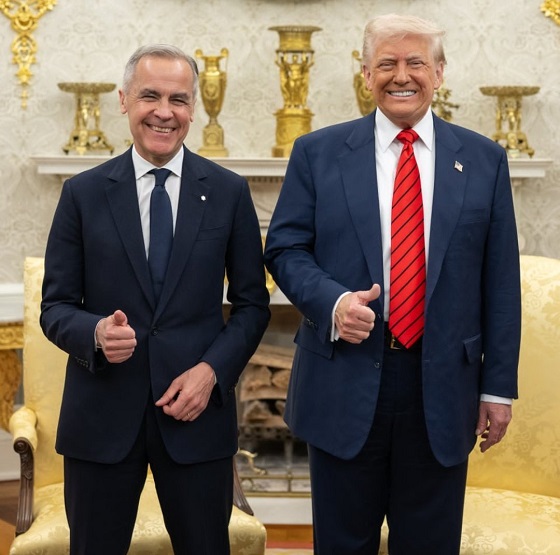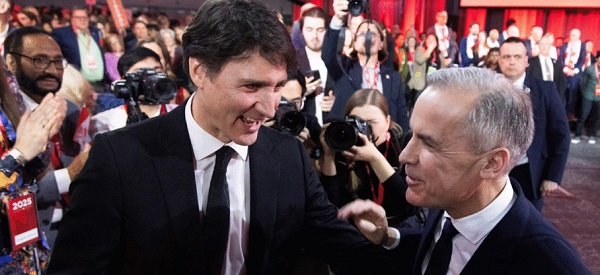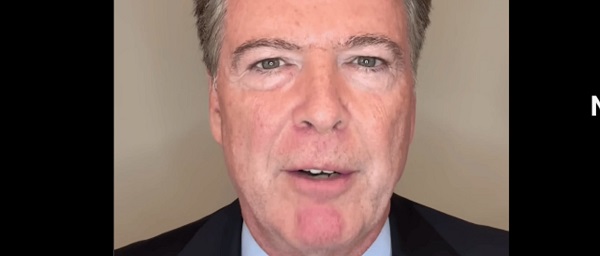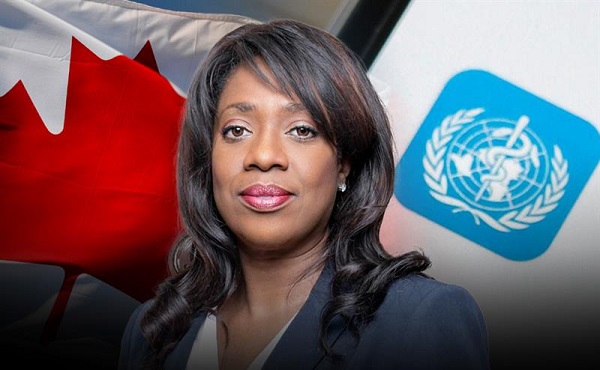Business
From ‘Elbows Up’ To ‘Thumbs Up’

From the National Citizens Coalition
National Citizens Coalition Slams Carney-Trump Meeting as ‘Insulting’ About-Face After Fear-Mongering Campaign Rhetoric
CANADA – From “elbows up” to thumbs up in record time.
The National Citizens Coalition (NCC) condemns Prime Minister Mark Carney’s cozy meeting with U.S. President Donald Trump, calling it a stark contradiction of the anti-American rhetoric that fueled Carney’s election campaign. The NCC asserts that Carney’s deferential White House visit undermines the combative pledges made to Canadians, revealing how the Liberals leveraged Trump’s tacit endorsement and the ‘Rally Around the Flag effect’ to secure their minority government.
During the April 2025 federal election, Carney and the Liberal Party campaigned on a platform of staunch resistance to Trump’s trade war and his provocative “51st state” rhetoric, inflaming tensions by warning that Trump sought to “break us so America can own us.” This messaging galvanized voters on the left, particularly the collapsing NDP base and many over-55s, with polls showing a surge in Liberal support driven entirely by anti-Trump sentiment. Yet, just days after securing victory, Carney’s decision to behave in stark contrast to such rhetoric betrays the trust of Canadians who believed in his hardline stance, and in particular, betrays the young Canadians who voted in defiance of “51st state” nonsense and American election interference, but who also had major additional priorities that have been ignored by a decade of Liberal ruin.
“Mark Carney sold Canadians a story of aggressive defiance against Trump, but this meeting proves he’s more interested in reaping the rewards than holding convictions,” says NCC President Peter Coleman. “Carney’s campaign leaned heavily on fearmongering about Trump, yet here he is shaking hands, laughing, and all but sitting idly by as he’s insulted, with the very man he claimed threatened our sovereignty. This isn’t leadership—it’s hypocrisy.”
The NCC contends that Trump’s public comments, including his refusal to rule out making Canada the 51st state, however flippant the bargaining tactic, were strategically exploited by the Liberals to consolidate left-leaning voters fearful of Conservative leader Pierre Poilievre’s perceived Trump-like style.
“Trump’s shadow loomed large over this election, and the Liberals milked it for every vote,” Coleman adds. “Canadians deserve to know if Carney’s tough talk was just a ploy to ride anti-Trump sentiment to power, only to cozy up to him afterward. This smells like a backroom deal between the two, that benefited the Liberals at the expense of much-needed hope and change, and honest and ethical conversations about the need for renewed pride in who we are, and a return to Canadian sovereignty.”
The NCC demands Carney explain how this meeting aligns with his fear-mongering on the campaign trail. Canadians deserve transparency about more of Carney’s true motives, which also may not match his statements and behaviours to date.
The National Citizens Coalition calls on all Canadians to hold Carney accountable for this cynical about-face. “We will not stand idly by while Carney exploits sovereignty concerns and election interference for political points,” Coleman concludes. “If this level of decorum had been any kind of consistent, if he hadn’t just run a fearful, pandemic-style campaign that robbed so many Canadians of hope and further inflamed alienation in the West, that’s one thing. But it’s time to reclaim the Canadian Dream from low-cunning leaders who say one thing and do another. He may be better house-broken than Trudeau, and on that, there is room for faint praise. But who really is Mark Carney? Why did the legacy media seem so disinterested in vetting him? And what does he really believe?”
About the National Citizens Coalition: Founded in 1967, the National Citizens Coalition is Canada’s pioneer non-profit conservative organization, dedicated to championing common-sense values, defending taxpayer interests, and promoting a strong, proud, and free Canada.
Business
Canada Is Still Paying The Price For Trudeau’s Fiscal Delusions

From the Frontier Centre for Public Policy
By Lee Harding
Trudeau’s reckless spending has left Canadians with record debt, poorer services and no path back to a balanced budget.
It’s time for Canada to break free from Trudeau’s big-spending legacy. With soaring deficits, mounting debt, and stalled growth, we need a budget that cuts red tape, flattens taxes, and puts the economy first.
Justin Trudeau may be gone, but the economic consequences of his fiscal approach, chronic deficits, rising debt costs and stagnating growth, are still weighing heavily on Canada.
Before becoming prime minister, Justin Trudeau famously said, “The budget will balance itself.” He argued that if expenditures stayed the same, economic growth would drive higher tax revenues and eventually outpace spending. Voila–balance!
But while the theory may have been sound, Trudeau had no real intention of pursuing a balanced budget. In 2015, he campaigned on intentionally overspending and borrowing to build infrastructure, arguing that low interest rates made it the right time to run deficits.
This argument, weak in its concept, proved even more flawed in practice. Post-pandemic deficits have been horrendous, far exceeding the modest overspending initially promised. The budgetary deficit was $327.7 billion in 2020–21, $90.3 billion the year following, and between $35.3 billion and $61.9 billion in the years since.
Those formerly historically low interest rates are also gone now, partly because the federal government has spent so much. The original excuse for deficits has vanished, but the red ink and Canada’s infrastructure deficit remain.
For two decades, interest payments on federal debt steadily declined, falling from 24.6 per cent of government revenues in 1999–2000 to just 5.9 per cent in 2021–22, thanks largely to falling interest rates and prior fiscal restraint. But that trend has reversed. By 2023–24, payments surged past 10 per cent for the first time in over a decade, as rising interest rates collided with record federal debt built up under Trudeau.
Rising debt costs are only part of the story. Federal revenues aren’t what they could have been because Canada’s economy has stagnated. Population growth pads our overall GDP growth stats, but masks our productivity problem. From 2014 to 2022, Canada had near-lowest GDP growth among 30 countries in the Organization for Economic Co-operation and Development. Canada’s average growth rate during that period (0.6 per cent) was only ahead of Luxembourg (0.5 per cent) and Mexico (0.4 per cent).Why should a country like Canada, so blessed with natural resources and know-how, do so poorly? Capital investment has fled because our government has made onerous regulations, especially hindering our energy industry. In theory, there’s now a remedy. Thanks to new legislation, the Carney government can extend its magic sceptre to those who align with its agenda to fast-track major projects and bypass the labyrinth it created. But unless you’re onside, the red tape still strangles you.
But as the private sector withers under red tape, Ottawa’s civil service keeps ballooning. Some trimming has begun, rattling public sector unions. Still, Canada will be left with at least five times as many federal tax employees per capita as the U.S.
Canada also needs to ease its hell-bent pursuit of net-zero carbon emissions. Hydrocarbons still power the Canadian economy, from vehicles to home heating, and aren’t practically replaceable. Canada has already demonstrated that pursuing net-zero targets can result in near-zero per capita growth. Despite high immigration, the OECD projects Canada to have the lowest overall GDP growth from 2030 to 2060.
The Nov. 4 release of the federal budget is better late than never. So would be a plan to grow the economy, slash red tape and eliminate the deficit. But we’re unlikely to get one.
Lee Harding is a research fellow with the Frontier Centre for Public Policy.
Business
Canadians responsible for $2.3 trillion in government debt: Every single person in Alberta owes $40,939

From the Fraser Institute
By Jake Fuss, Tegan Hill and William Dunstan
The Carney government plans to table its long-awaited federal budget on Nov. 4. In the summer, Prime Minister Carney announced billions of dollars in new spending that could push this year’s federal deficit above $90 billion, which would add significantly to the federal debt.
Indeed, the federal government, and the provincial governments, have racked up mountains of debt over the past decade and a half, with no end in sight.
According to a recent study, combined federal and provincial government net debt (total debt minus financial assets) nearly doubled (inflation-adjusted) from $1.2 trillion in 2007/08 to a projected $2.3 trillion at the end of 2024/25.
Putting this debt in per-person terms helps illustrate its scale.
Combined provincial and federal net debt per person ranges from a low of $40,939 in Alberta to a high of $68,861 in Newfoundland and Labrador. Combined federal and provincial net debt represents total provincial net debt plus each province’s share of federal net debt, which the study allocated to each province based on a five-year average (2020-2024) of their share of Canada’s population.
Of course, Canadians are ultimately responsible for financing this debt. Indeed, governments, like households, must pay interest on their debt, and taxpayers fund these debt interest payments. When tax dollars are spent on debt interest payments, those same dollars cannot be spent on important programs such as health care or used to provide tax relief.
The federal government spent a projected $53.8 billion on debt interest payments in 2024/25, more than it spent on the Canada Health Transfer ($52.1 billion), which supports provincial health-care systems. For many provinces, debt interest costs are the fourth-largest expense after health care, education and social services.
Many governments do not plan to stop adding to their net debt. Federally, the government’s recent tax and spending commitments will likely result in deficits of more than $70 billion each year through 2028/29. Additionally, six provinces—Alberta, British Columbia, Quebec, New Brunswick, Nova Scotia and Prince Edward Island—project budget deficits each year from 2025/26 to 2027/28. All provinces except Saskatchewan project deficits in 2025/26.
But there’s good news. Past governments have shown it’s possible to restrain spending and reduce debt. In fact, the 2008/09 recession marked a turning point for government deficits and debt in Canada. From the mid-1990s to the late-2000s, it was a different story, as the federal government and many provincial governments sought to restrain spending, balance their budgets and limit debt accumulation.
But now and for many years, many governments across Canada have run deficits and accumulated debt, at great cost to taxpayers. It’s time governments develop real plans to address their ballooning debt burdens. The upcoming Carney budget is a good place to start.
-

 armed forces21 hours ago
armed forces21 hours agoSecretive Lockheed Martin Skunk Works reveals latest high-tech military drone
-

 International20 hours ago
International20 hours agoEverything has changed. Again.
-

 Bruce Dowbiggin2 days ago
Bruce Dowbiggin2 days agoWhat We Had Here Is A Failure To Communicate
-

 Business1 day ago
Business1 day agoGun Buyback Program creating criminals out of law abiding citizens and directing police away from actual crime
-

 Daily Caller2 days ago
Daily Caller2 days ago‘Let’s Have A Trial’: Comey Responds To Indictment
-

 Business2 days ago
Business2 days agoCritics Accuse YouTube of Dragging Out Return Process for Banned Channels
-

 Censorship Industrial Complex2 days ago
Censorship Industrial Complex2 days agoConservative MP Leslyn Lewis warns Liberals’ ‘hate’ bill will allow for prosecution of free speech
-

 Opinion1 day ago
Opinion1 day agoThe City of Red Deer’s financial mess – KPMG report outlines failure of council to control spending





